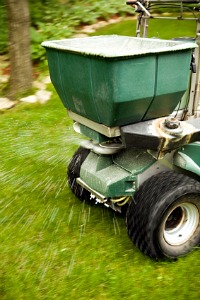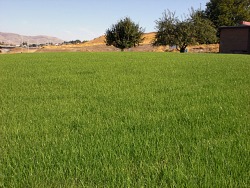Yard Maintenance Tips for Cool-Season Grasses
I consider fall lawn care tasks such as fertilizing, core aeration, over-seeding and thatch control to be very important to growing a thick, healthy lawn.
The planting and growing season for cool-season grasses really starts in early fall–not the spring–the warm days and cool nights create ideal conditions for building strong, deep root systems that will help your lawn survive the summer stress from heat and drought.
Fall is the best time to repair lawns, plant new grass and control weeds.
Common cool-season grasses used in lawns include:
- Tall Fescues
- Fine Fescues
- Kentucky Bluegrass
- Perennial Ryegrass
Annual Growth Cycle of Cool-Season Grasses

This graph illustrates annual root and shoot growth and development. Note the shoot growth and root development that takes place in the fall.
The goal of a healthy lawn maintenance program is to encourage a strong, deep root system to prepare for hot and dry weather.
Tip #1: Best Time to Fertilize Cool-Season Grasses

Fall fertilizer applications are very beneficial. The growing conditions are perfect for improving grass density, increasing carbohydrate storage and root development.
Two or three fertilizer applications of 1/2 to 1 pound of nitrogen per 1000 ft2 spaced out 4 to 6 weeks is highly recommended and much more beneficial than heavy spring applications.
Remember the acronym SOD (September, October, December). The 1st fertilizer application should be in early September. Then October when the weather starts to cool and shoot growth is not as heavy. The final application of a “winterizing” fertilizer should be in late November or early December while the grass is still green. The supplemental potassium in winterizing fertilizer is very effective in improving winter hardiness.
More fall fertilizer tips:
- Choosing the Best Lawn Fertilizer
- How to Calibrate a Drop Spreader
- Benefits of Natural and Organic Fertilizers
Want to know what your lawn needs and when to apply it?
Let the turfgrass experts on Sunday take care of the technical stuff.
Have you heard about the Sunday Smart Lawn Plan? It’s simple, do-it-yourself natural lawn care that’s customized to your soil, climate, and lawn. Delivered to you right when you need it. You apply the nutrient packets with the included hose-end sprayer…simple, professional results!
Sunday’s plant and soil nutrient products are made from food waste, seaweed, and molasses. The natural additives stimulate plant growth and activate soil life.
This is Super Environmentally Friendly lawn care!
Fall Lawn Care Tip #2: Core Aeration

Fall is the best time to aerate lawns. Lawns growing in heavy clay soils or areas that get a lot of traffic should be core aerated once a year. I recommend aerating every lawn once a year because it is one of the most neglected but most beneficial fall lawn care tasks.
Click to read more about core aeration.
Fall Lawn Care Tip #3: Weed Control
The best time to kill weeds with broadleaf herbicides is when they are actively growing – this is usually in late spring and early fall.
Click here for more information on weed identification and control: How to Kill Weeds.
There are a few natural/organic options available; however, they are non-selective – meaning they kill both grass and weeds – and not as effective as conventional herbicides.
Read more about Organic Weed Control.
Fall Lawn Care Tip #4: Dethatching
Thatch is a build-up of partially decomposed plant material – usually creeping rhizomes and “stemmy” shoots. A little bit of thatch is normal but too much can cause the decline of a turf stand. Thatch build-up of more than 1/2 inch needs to be removed by power raking.
The main reason it is best to dethatch in the fall is because power raking is hard on grass plants and often exposes soil to weed invasion. The ideal fall growing conditions also allow the turfgrass stand to recover quickly.
Read more – How and When to Dethatch a Lawn
Fall Lawn Care Tip #5: Lawn Repair, Renovation and Planting New Grass

Fall Hydroseeding – New Lawn

Results After 2 Weeks
Late summer through early fall is the best time to plant new cool-season grasses. The cool nights and warm days are ideal for starting new seeds or laying sod.
A perfect time to over-seed thin lawns or repair bare spots is right after aerating or power raking – these practices create a good planting bed in established lawns by exposing the soil the seeds need to germinate.
Cool Tool! Lawn Repair Made Easy
The product link below is an Amazon affiliate link. This means if you click on the link and purchase the item, I will receive an affiliate commission at no extra cost to you. All opinions remain my own. PLEASE READ MY DISCLOSURE FOR MORE INFORMATION.
The Grass Stitcher makes repairing lawns easy. This handy tool preps bare and thin areas for seeding.
https://youtube.com/watch?v=BGZJaocQiVU%3Frel%3D0
Order EnRoot Seed Stitcher PRO from Amazon.
Fall Lawn Care Tip #6: Winterize your Equipment
Prepare your equipment for winter storage.
How to Winterize a Home Sprinkler System using the “blow out” method.
Improve the reliability of your equipment by preparing your mowers, leaf blowers, string trimmers, and chainsaws for winter storage. How to Winterize Your Outdoor Power Equipment.

Fall Lawn Care Questions
Question: In the fall I always aerate, over-seed, fertilize and lime. is this right?
Answer: Yes, fall is the best time to aerate, over-seed and fertilize cool-season grasses. Lime should only be added if you have had your soil tested and it is recommended by the results. The reason for adding lime is to increase soil pH. The only way to know how much to apply – or if you even need lime – is by having your soil tested.
More Q & A:
When can I apply weed and feed on the newly laid lawn?
Is it better to rake leaves or just mulch them with my lawn mower?

